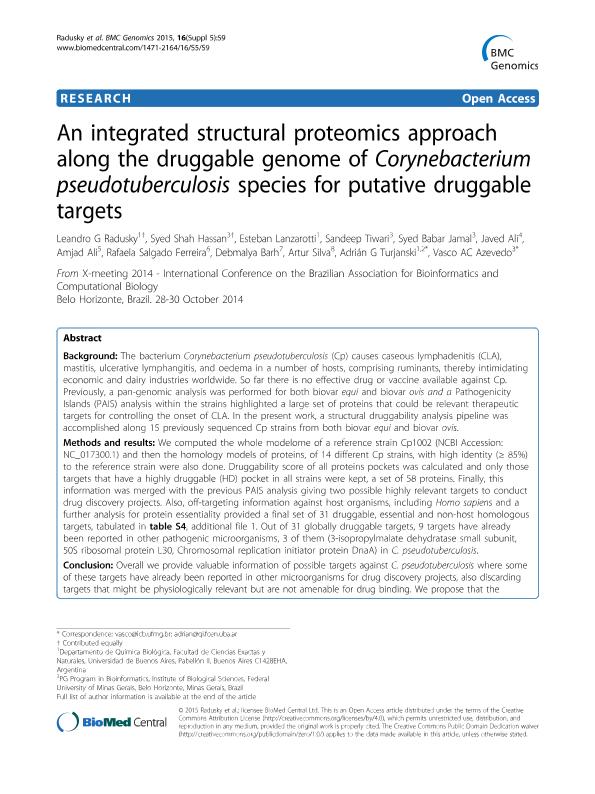Mostrar el registro sencillo del ítem
dc.contributor.author
Radusky, Leandro Gabriel

dc.contributor.author
Hassan, Syed Shah
dc.contributor.author
Lanzarotti, Esteban Omar

dc.contributor.author
Tiwari, Sandeep
dc.contributor.author
Jamal, Syed Babar
dc.contributor.author
Ali, Javed
dc.contributor.author
Ali, Amjad
dc.contributor.author
Ferreira, Rafaela Salgado
dc.contributor.author
Barh, Debmalya
dc.contributor.author
Silva, Artur
dc.contributor.author
Turjanski, Adrian

dc.contributor.author
Azevedo, Vasco AC
dc.date.available
2018-09-10T21:13:19Z
dc.date.issued
2015-05
dc.identifier.citation
Radusky, Leandro Gabriel; Hassan, Syed Shah; Lanzarotti, Esteban Omar; Tiwari, Sandeep; Jamal, Syed Babar; et al.; An integrated structural proteomics approach along the druggable genome of Corynebacterium pseudotuberculosis species for putative druggable targets; BioMed Central; BMC Genomics; 16; 5; 5-2015; 1-8
dc.identifier.issn
1471-2164
dc.identifier.uri
http://hdl.handle.net/11336/58994
dc.description.abstract
Background: The bacterium Corynebacterium pseudotuberculosis (Cp) causes caseous lymphadenitis (CLA), mastitis, ulcerative lymphangitis, and oedema in a number of hosts, comprising ruminants, thereby intimidating economic and dairy industries worldwide. So far there is no effective drug or vaccine available against Cp. Previously, a pan-genomic analysis was performed for both biovar equi and biovar ovis and a Pathogenicity Islands (PAIS) analysis within the strains highlighted a large set of proteins that could be relevant therapeutic targets for controlling the onset of CLA. In the present work, a structural druggability analysis pipeline was accomplished along 15 previously sequenced Cp strains from both biovar equi and biovar ovis. Methods and results: We computed the whole modelome of a reference strain Cp1002 (NCBI Accession: NC_017300.1) and then the homology models of proteins, of 14 different Cp strains, with high identity (≥ 85%) to the reference strain were also done. Druggability score of all proteins pockets was calculated and only those targets that have a highly druggable (HD) pocket in all strains were kept, a set of 58 proteins. Finally, this information was merged with the previous PAIS analysis giving two possible highly relevant targets to conduct drug discovery projects. Also, off-targeting information against host organisms, including Homo sapiens and a further analysis for protein essentiality provided a final set of 31 druggable, essential and non-host homologous targets, tabulated in table S4, additional file 1. Out of 31 globally druggable targets, 9 targets have already been reported in other pathogenic microorganisms, 3 of them (3-isopropylmalate dehydratase small subunit, 50S ribosomal protein L30, Chromosomal replication initiator protein DnaA) in C. pseudotuberculosis. Conclusion: Overall we provide valuable information of possible targets against C. pseudotuberculosis where some of these targets have already been reported in other microorganisms for drug discovery projects, also discarding targets that might be physiologically relevant but are not amenable for drug binding. We propose that the constructed in silico dataset might serve as a guidance for the scientific community to have a better understanding while selecting putative therapeutic protein candidates as druggable ones as effective measures against C. pseudotuberculosis.
dc.format
application/pdf
dc.language.iso
eng
dc.publisher
BioMed Central

dc.rights
info:eu-repo/semantics/openAccess
dc.rights.uri
https://creativecommons.org/licenses/by-nc-sa/2.5/ar/
dc.subject
Bioinformatica
dc.subject
Corynebacterium Tuberculosis
dc.subject
Drogabilidad
dc.subject
Modelado por Homologia
dc.subject.classification
Ciencias de la Computación

dc.subject.classification
Ciencias de la Computación e Información

dc.subject.classification
CIENCIAS NATURALES Y EXACTAS

dc.title
An integrated structural proteomics approach along the druggable genome of Corynebacterium pseudotuberculosis species for putative druggable targets
dc.type
info:eu-repo/semantics/article
dc.type
info:ar-repo/semantics/artículo
dc.type
info:eu-repo/semantics/publishedVersion
dc.date.updated
2018-09-04T19:05:58Z
dc.journal.volume
16
dc.journal.number
5
dc.journal.pagination
1-8
dc.journal.pais
Reino Unido

dc.journal.ciudad
Londres
dc.description.fil
Fil: Radusky, Leandro Gabriel. Consejo Nacional de Investigaciones Científicas y Técnicas; Argentina. Universidad de Buenos Aires. Facultad de Ciencias Exactas y Naturales. Departamento de Química Biológica; Argentina
dc.description.fil
Fil: Hassan, Syed Shah. Universidade Federal de Minas Gerais; Brasil
dc.description.fil
Fil: Lanzarotti, Esteban Omar. Consejo Nacional de Investigaciones Científicas y Técnicas; Argentina. Universidad de Buenos Aires. Facultad de Ciencias Exactas y Naturales. Departamento de Química Biológica; Argentina
dc.description.fil
Fil: Tiwari, Sandeep. Universidade Federal de Minas Gerais; Brasil
dc.description.fil
Fil: Jamal, Syed Babar. Universidade Federal de Minas Gerais; Brasil
dc.description.fil
Fil: Ali, Javed. Kohat University of Science and Technology; Pakistán
dc.description.fil
Fil: Ali, Amjad. National University of Sciences & Technology; Pakistán
dc.description.fil
Fil: Ferreira, Rafaela Salgado. Universidade Federal de Minas Gerais; Brasil
dc.description.fil
Fil: Barh, Debmalya. Institute of Integrative Omics and Applied Biotechnology; Pakistán
dc.description.fil
Fil: Silva, Artur. Federal University of Pará; Brasil
dc.description.fil
Fil: Turjanski, Adrian. Consejo Nacional de Investigaciones Científicas y Técnicas. Oficina de Coordinación Administrativa Ciudad Universitaria. Instituto de Química, Física de los Materiales, Medioambiente y Energía. Universidad de Buenos Aires. Facultad de Ciencias Exactas y Naturales. Instituto de Química, Física de los Materiales, Medioambiente y Energía; Argentina. Universidad de Buenos Aires. Facultad de Ciencias Exactas y Naturales. Departamento de Química Biológica; Argentina
dc.description.fil
Fil: Azevedo, Vasco AC. Universidade Federal de Minas Gerais; Brasil
dc.journal.title
BMC Genomics

dc.relation.alternativeid
info:eu-repo/semantics/altIdentifier/doi/https://dx.doi.org/10.1186/1471-2164-16-S5-S9
dc.relation.alternativeid
info:eu-repo/semantics/altIdentifier/url/https://bmcgenomics.biomedcentral.com/articles/10.1186/1471-2164-16-S5-S9
Archivos asociados
